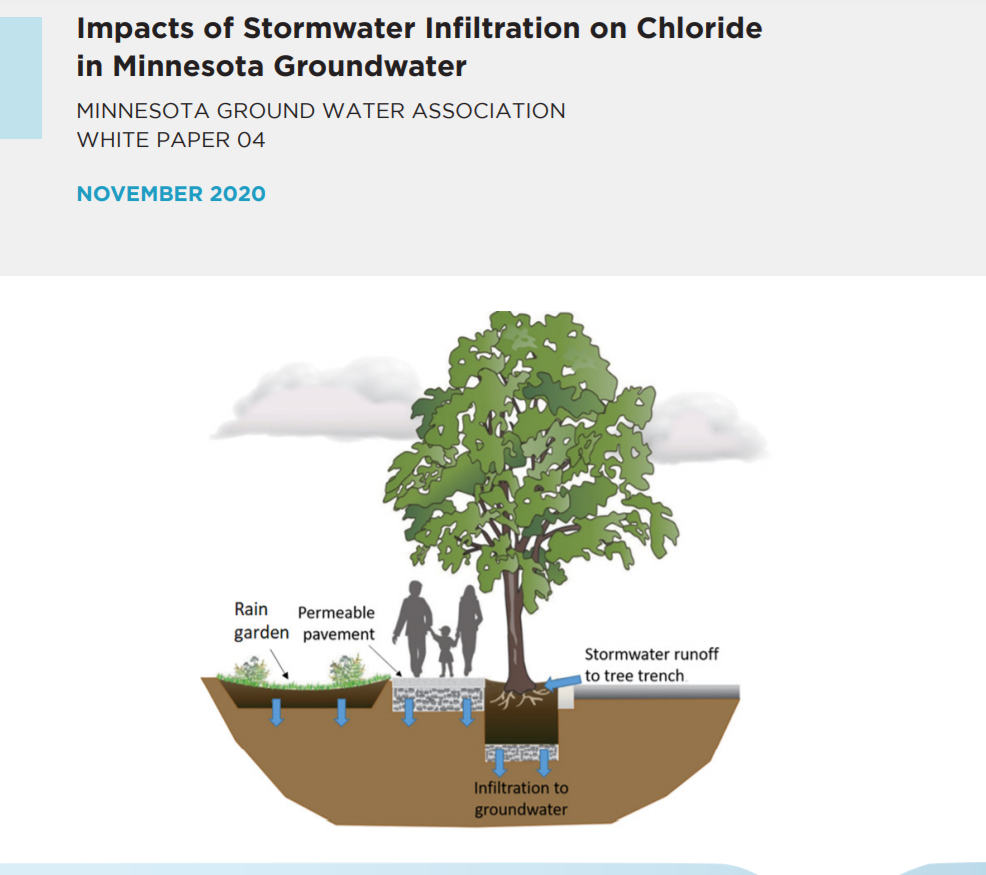
The Stormwater White Paper team has now completed the fourth in a series of white paper reports for MGWA. This new one focuses on chloride in stormwater infiltration.
Executive Summary
Chloride concentrations are increasing in Minnesota’s surface waters and groundwater. Fifty lakes or rivers currently exceed the 230 mg/L chronic aquatic life standard and are thus classified as chloride-impaired. Shallow groundwater monitoring in the Twin Cities Metro Area shows that nearly 30 percent of sampled wells exceed the non-health-based Secondary Maximum Contaminant Level drinking water standard of 250 mg/L. Typical chloride concentrations in shallow urban groundwater are 60-80 mg/L, while “background” (forested area) concentrations are typically less than 5 mg/L.
While there are several natural and anthropogenic sources of chloride, use of chloride-based deicers accounts for 42 percent of the annual chloride contribution to Minnesota’s environment. In urban areas, deicer use accounts for most of the chloride load to surface water and shallow groundwater.
Deicer application rates are the primary determinant of chloride concentrations in stormwater runoff. In winter, deiced area runoff frequently exceeds 1000 mg/L, and sometimes 10,000 mg/L chloride, while concentrations are typically below 50 mg/L in non-deiced areas. Infiltration of stormwater runoff is a favored management strategy. There are many water quality and hydrologic benefits from infiltration, but effective chloride treatment remains infeasible. The effects of increased stormwater infiltration are largely uncharacterized; there are no known studies of stormwater infiltration impacts on groundwater chloride at the regional scale.
We developed an estimation approach for groundwater chloride budgets. We then varied three inputs directly related to stormwater infiltration: stormwater runoff chloride concentration, impervious surface (%), and infiltration implementation (%). While increasing each variable effectively increases groundwater chloride loading, runoff concentration appears to be the most important factor.
Although there is still a need to better understand chloride’s environmental sources and fate, we know that treatment and remediation remain highly impractical. Thus, we identify the following upstream management strategies to reduce stormwater-related chloride sources to the environment:
● Identify and map groundwater areas vulnerable to chloride contamination by stormwater infiltration
● Properly site and design infiltration practices to minimize impacts to groundwater and to surface waters that receive significant baseflow
● Avoid storing snow containing chloride deicers in infiltration practices
● Use permeable pavements, which require little or no deicer use, where appropriate
Ultimately, the only effective long-term strategy to manage stormwater-related chloride in receiving waters is to decrease the use of chloride-based deicers.
Link to full report
MGWA is committed to developing a just, equitable, and inclusive groundwater community. Click on the button below to read MGWA’s full diversity statement.